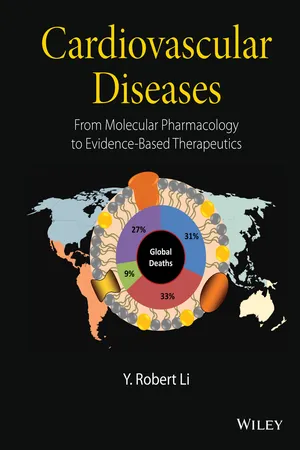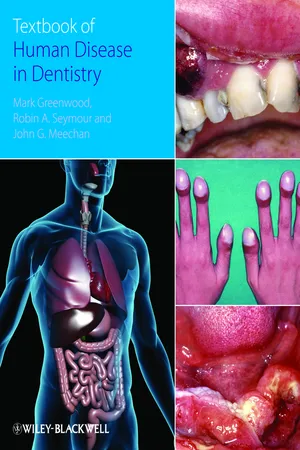Biological Sciences
Cardiovascular Disease
Cardiovascular disease refers to a group of disorders affecting the heart and blood vessels, including conditions such as coronary artery disease, heart failure, and stroke. It is often caused by a combination of genetic, environmental, and lifestyle factors, and is a leading cause of death worldwide. Prevention and management strategies typically involve lifestyle modifications, medication, and sometimes surgical interventions.
Written by Perlego with AI-assistance
Related key terms
6 Key excerpts on "Cardiovascular Disease"
- eBook - ePub
Cardiovascular Diseases
From Molecular Pharmacology to Evidence-Based Therapeutics
- Y. Robert Li(Author)
- 2015(Publication Date)
- Wiley(Publisher)
In order to define the term Cardiovascular Diseases, it is imperative to first provide an overview of the cardiovascular system. Briefly, cardiovascular system refers to an integrated organ system consisting of the heart and blood vessels. Blood flows through a network of blood vessels that extend between the heart and the peripheral tissues. These blood vessels are subdivided into a pulmonary circuit, which carries blood to and from the gas exchange surface of the lungs, and a systemic circuit, which transports blood to and from the rest of the body. Each circuit begins and ends at the heart, and the blood vessels and the heart collectively constitute the cardiovascular system. As noted, blood is a central player in the cardiovascular system, and hence, study of the cardiovascular system inevitably involves examination of the blood, including its components and functionality. It should be noted that cardiovascular system and circulatory system are frequently used interchangeably; however, strictly, the circulatory system is composed of the cardiovascular system, which distributes blood, and the lymphatic system, which distributes lymph.Cardiovascular Diseases refer to a group of diseases involving the heart, blood vessels, or the sequelae of poor blood supply due to a decreased vascular supply and include (i) diseases of the heart, (ii) vascular diseases of the brain (also known as cerebrovascular diseases), and (iii) diseases of other blood vessels (Fig. 1.1 ). Hence, Cardiovascular Diseases affect the heart, the brain, and other organs or systems of the human body.Definition of Cardiovascular Diseases. The term Cardiovascular Diseases refers to a group of diseases, including the diseases of the heart, vascular diseases of the brain, and the diseases of other blood vessels.Figure 1.11.3 Classification of Cardiovascular Diseases
1.3.1 Classification Based on Anatomical Location
Cardiovascular Diseases are classified in various ways. One scheme is based primarily on the anatomical location of the disease pathogenesis and broadly classifies Cardiovascular Diseases into two categories: (i) diseases of the heart and (ii) vascular diseases (Fig. 1.2 ).Figure 1.2 - Oliver Jones(Author)
- 2014(Publication Date)
- CAB International(Publisher)
3 Cardiovascular Disease and HealthJacqueline E. Wood*Waikato Institute of Technology, Hamilton, New Zealand3.1 Introduction
Cardiovascular Disease is currently one of the world’s leading causes of morbidity (Van Lente, 2000; Dadu et al ., 2012). The term covers a range of conditions involving dysfunction of blood vessels and the heart. The consequences of aberrant blood vessel and cardiac function are complex and multiple, potentially affecting most tissues and organs in the body. Many of these heart problems stem from atherosclerosis, which correlates well with poor diet and/or metabolic disorders that lead to excess lipids in the blood and insulin-resistant diabetes (Lee and Libby, 1997; Wilson et al ., 1998; Lakka et al ., 2002). Although atherosclerosis is a common starting point for Cardiovascular Disease, other causes such as congenital disorders and viral or bacterial infections that damage the heart muscle also occur (Lee and Libby, 1997; Marks et al ., 2002; Seeley et al ., 2008).Most patients suffering with Cardiovascular Disease symptoms are subjected to electrocardiograms to investigate the electric signals sent to the heart (Marks et al ., 2002; Vasan, 2006). However, because of the recent developments in analytical chemistry and the ease of measurement, increasing numbers of studies indicate that it may be possible to use metabolomics and systems biology to establish the patient’s state of health using biomarkers (Vasan, 2006; May and Wang, 2008; Mayr, 2008).To provide clinically useful information about the state of the patient’s current health and predict their future state of health, biomarkers must be able to be reliably measured in a cost-effective and time-efficient manner (Vasan, 2006; Mayr, 2008; Emdin et al ., 2009; Dadu et al ., 2012). Ideally these biomarkers should be in readily accessible biofluids such as urine, saliva or serum that can be obtained without invasive procedures (Vasan, 2006; May and Wang, 2008). Cardiovascular biomarkers such as natriuretic peptides, pro-inflammatory cytokines, reactive protein C and cholesterol that are present in blood are currently used for risk assessment, or diagnosis and/or prognosis (Koenig and Khuseyinova, 2007). However, recent research has shown that potential biomarkers such as collagen fragments and some prostaglandins are more easily measured in urine (Schwedhelm et al ., 2004; Zimmerli et al- eBook - ePub
Cardiovascular Disease
Diet, Nutrition and Emerging Risk Factors
- Keith N. Frayn, Sara Stanner, Sarah Coe(Authors)
- 0(Publication Date)
- Wiley-Blackwell(Publisher)
This report is concerned with factors that relate to the risk of developing CVD and how these may be influenced by diet. CVD includes arterial disease affecting the blood supply to the heart or to the brain, or to the peripheral regions of the body. The term CVD refers to a number of individual diseases affecting the cardiovascular system. In some cases, in this report, we will use the term ‘Cardiovascular Diseases’ when we wish to make this clear. Cardiovascular Diseases account for over half of all deaths in middle age and one‐third of all deaths in old age in most developed countries. Globally CVDs account for 30% of all deaths.There are many links between CVD and metabolic derangements, especially type 2 diabetes and obesity‐related traits. For that reason, the term ‘cardiometabolic risk’ is often used to cover the combined risk of both CVD and metabolic disease, and will be used in this way throughout this report.Research over the last decade has led to a greater understanding of the independent contribution of several factors identified in the initial report to cardiovascular risk. Although we have continued to use the term ‘emerging risk factors’ throughout this report to distinguish them from the classical risk factors, many are now established in terms of their ability to predict CVD risk.1.3.1 Coronary Heart Disease
CHD is a condition in which the walls of the arteries supplying blood to the heart muscle (coronary arteries) become thickened. This thickening, caused by the development of lesions in the arterial wall, is called atherosclerosis; the lesions are called plaques. Atherosclerosis can restrict the supply of blood to the heart muscle (the myocardium) and may manifest to the patient as chest pain on exertion (angina) or breathlessness on exertion. If the cap covering the plaque ruptures, exposing the contents to the circulation, the blood may clot and obstruct the flow completely, resulting in a MI or heart attack. CHD is also known as ischaemic heart disease. - eBook - ePub
Basic Pathology
An introduction to the mechanisms of disease
- Sunil R. Lakhani, Caroline J. Finlayson, Susan A. Dilly, Mitesh Gandhi(Authors)
- 2016(Publication Date)
- CRC Press(Publisher)
Some solutions to these problems have been found; thus affected segments of piping can be replaced (arterial bypass grafts), pumps can be tinkered with (valve grafts) or replaced (heart transplants), high pressure causing strain on the system can be relieved (anti-hypertensive drugs), and the narrowed vessels may be stretched with balloon catheters and then stented to keep them open. Of course these are usually only partial solutions and there is no doubt that prevention is the best medicine.This moves us naturally from the mechanistic, reductionist approach to a more holistic one that takes account of our genetic background, environment and lifestyle. Consider Fig. 2 ; this is an integrated gene by environment (GxE) report card for a personal genome.DictionaryCommon terms in cardiovascular disordersEmbolus: intravascular solid, liquid or gaseous mass carried in the blood from its origin and lodged in another siteThrombus: solid mass of blood formed within the cardiovascular system involving the interaction of endothelial cells, platelets and the coagulation cascadeBlood clot: solid mass of blood formed by the action of the coagulation cascadeInfarct: localised area of ischaemic tissue necrosis generally caused by an impaired blood supplyHaematoma: extravascular accumulation of clotted bloodHaemorrhage: discharge of blood from the vascular compartment into the extravascular body spaces or to the exteriorPetechiae, purpura, ecchymoses: small haemorrhagesHyperaemia: an increased volume of intravascular blood in an affected tissue which may result from increased flow (active hyperaemia) or reduced drainage (passive hyperaemia = congestion)Figure 1 The cardiovascular system can be likened to a domestic plumbing system.The environmental risk factors are around the circumference and the lines show their links to specific diseases. The diseases themselves however also interact so, for example, obesity increases the risk of hypertension and coronary artery disease. This graphic is about an individual’s risk of diseases based on analysis of their genome. The size and colour of the risk factors shows which changes in lifestyle would be likely to have greatest impact. For this person, it is smoking and exercise. That would also be true for most of the population but, if he had a different genome, the importance of the risk factors could be different; this is how personalised medicine could evolve over the next decade. In the following chapters, we will highlight a few of the most important genetic and environmental factors but remember that there are actually hundreds involved and full assessment of individual risk will require large databases and powerful computers. - eBook - ePub
Health Psychology
a Biopsychosocial Approach
- Hymie Anisman(Author)
- 2021(Publication Date)
- SAGE Publications Ltd(Publisher)
Cardiovascular and circulatory diseases are the greatest cause of death worldwide, and poor heart functioning has many other negative effects that ought to be considered. For example, poor heart functioning alters lifestyles, which encourages the development of still other illnesses, including dementia (Jefferson et al., 2010). On the positive side, across age groups, sex, and education categories, heart disease has been declining in most developed countries since the 1960s, although it has remained high among some groups, such as Native Americans. In Canada, heart disease has similarly been high among Indigenous people, varying with levels of social support, education, and the extent of socioeconomic disadvantages (Anand et al., 2019). The presence of CAD is at record high levels in Brazil, Russia, India, China, and South Africa (BRICS), but other than in Brazil, the frequency of CAD deaths has been declining (Zou et al., 2020). In contrast, CAD has been increasing in developing or transitional countries, probably owing to lifestyle changes and the presence of pollutants that come with industrial development (Yusuf et al., 2020). Thus, it is likely that Cardiovascular Disease will remain the leading cause of death for some time, unless something else comes along that eclipses it.Development of CAD
When damage occurs on the thin layer of cells that line the inner portion of blood vessels (endothelium), monocytes, macrophages, and T cells infiltrate the site, where they release cytokines that promote inflammation and the formation of plaque, a semi-hard substance composed of cholesterol, fat, calcium, and fibrin (Hansson & Hermansson, 2011). With time, and repeated damage, plaque build-up will progress, typically covered by a thin fibrous layer of collagen (a component of connective tissue that holds the body together) and smooth muscle cells. Eventually, the restricted flow of blood to the heart (i.e., atherosclerosis) will result in symptoms becoming obvious and a formal diagnosis of CAD will follow. Events that increase blood flow and pressure, such as exertion or stressful experiences (technically referred to as hemodynamic stress), may cause the plaque to rupture, resulting in a thrombosis or blood clot that goes into circulation, causing blockage of a main artery and the occurrence of myocardial infarction (MI; heart attack) as well as a certain type of stroke (ischemic stroke). Although plaque begins to form years earlier, it’s common for men and women to first be diagnosed with CAD in their 50s and 60s once blood flow is substantially reduced. In general, CAD comes to attention when individuals feel chest pain (angina pectoris) that arises when insufficient oxygenated blood gets to the heart, which is most notable in response to physical exertion, but can also be elicited by psychological stressors. In some instances myocardial ischemia and the accompanying angina (pressure or squeezing in the chest, pain in the shoulder, arm, neck, jaw, or back, or appearing as indigestion) is transient, resolving with discontinuation of behaviors that placed a load on the heart (stable angina) or through medications that increase blood supply (e.g., nitroglycerine placed under the tongue). However, as the disease progresses, ischemia may become longer lasting (more than 10 minutes) and unstable - eBook - ePub
- Mark Greenwood, Robin Seymour, John Meechan(Authors)
- 2013(Publication Date)
- Wiley-Blackwell(Publisher)
The blood supply to the myocardium is carried via the right and left coronary arteries, which branch from the aorta immediately above the aortic valve. These are ‘end arteries’, which means that any blockage cannot be bypassed, and will result in damage to the area of muscle supplied by the blocked artery. Venous blood passes via the coronary veins to the coronary sinus, which runs in the atrio-ventricular groove, and drains directly into the right atrium.Cardiovascular pathology
Cardiovascular Disease (CVD) is the main cause of death in most western societies. For example, in the UK, >1 in 3 people (38%) dies of CVD and it is also one of the main causes of premature death (death before the age of 75 years). The main forms of CVD are coronary heart disease and cerebral vascular disease.Figure 5A.2 A diagram of the cardiac conducting system.Atherosclerosis
Atherosclerosis is the most common vascular disease and affects only arteries. It is important in the pathogenesis of both coronary heart disease and cerebral vascular disease.Definitions
Atheroma is a condition that is characterised by the focal accumulation of lipid in the tunica intima of arteries. The lipid deposits have the texture and appearance of porridge, which is how the condition derives its name (Greek: athere gruel). Fibrosis develops in association with the lipid deposits, resulting in hardening or ‘sclerosis’; hence the term atherosclerosis, which is used synonymously with atheroma.Risk factors
The cause of atherosclerosis is unknown; however, there are risk factors that are associated with the development of the disease. The risk factors are summarised in Table 5A.1 .The incidence of atherosclerosis increases with age . The incidence in males
Learn about this page
Index pages curate the most relevant extracts from our library of academic textbooks. They’ve been created using an in-house natural language model (NLM), each adding context and meaning to key research topics.





